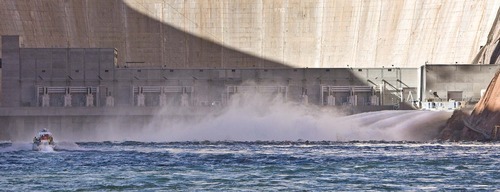This is an archived article that was published on sltrib.com in 2011, and information in the article may be outdated. It is provided only for personal research purposes and may not be reprinted.
Dam operators began tinkering with Colorado River flows through Glen Canyon years ago. They wanted to find the right balance to protect sensitive wildlife, optimize electricity, provide water to thirsty people, farmers and industry and preserve the spectacular environment in Grand Canyon National Park.
On Tuesday, U.S. Interior Secretary Ken Salazar announced his agency will assess how all of that is going.
The Bureau of Reclamation and the National Park Service have embarked on an in-depth environmental review aimed at developing long-term plans for managing the river and the dam.
"We need to make use of the latest science," Salazar said in a news release, "to develop and implement a structured, long-term management plan for the Glen Canyon Dam that adheres to the Law of the River, respects the interests of the tribal nations, and sustains the health of the Grand Canyon and the communities that depend on its water, consistent with the Grand Canyon Protection Act."
The review, including an extensive public process, marks the first time since 1996 that federal officials have undertaken an in-depth assessment of environmental conditions connected to dam operations.
Since that earlier review, officials have conducted three experimental high-flow releases through the Grand Canyon, most recently in 2008, in an effort to bolster endangered fish species and rebuild beaches and sandbars.
The Bureau of Reclamation, which oversees dam operations, and the National Park Service, which oversees Grand Canyon National Park and Glen Canyon National Recreation Area, will co-lead the environmental review.
State and tribal governmental agencies will play big roles, too. Public meetings have not been scheduled yet, but are expected to be part of the effort as soon as this fall.
David Nimkin, regional director for the National Parks Conservation Association, said his group welcomes a new environmental analysis to replace one that is now "obsolete." He estimated about $150 million has been spent on the scientific studies that will inform the new environmental study.
"Many of the old assumptions are wrong," he said. "We strongly support real adaptive management that can protect the greater Grand Canyon ecosystem."
Ted Rampton, government-affairs manager for Utah Associated Municipal Power Systems, said power users also support a comprehensive plan, because those who rely on Glen Canyon Dam have had to replace about a third of the power that would normally come from the dam under the adaptive management plans.
"There's a lot of competing," he said, "in terms of who benefits."
More on river study
O Read more about the new Glen Canyon Dam study.
> tinyurl.com/5sfz564



